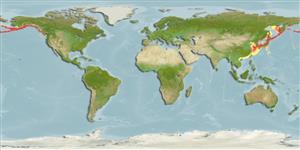Environment: milieu / climate zone / depth range / distribution range
Ecologia
marinhas demersal; intervalo de profundidade 0 - 604 m (Ref. 50550). Temperate; 66°N -
North Pacific: Hokkaido, Japan to the Bering Sea.
Comprimento de primeira maturação / Tamanho / Peso / Idade
Maturity: Lm 26.0, range 24 - 28 cm
Max length : 36.0 cm SL macho/indeterminado; (Ref. 559); common length : 27.0 cm TL macho/indeterminado; (Ref. 56557); peso máx. publicado: 800.00 g (Ref. 56557); idade máx. registrada: 12 anos (Ref. 56557)
Descrição suscinta
Morfologia | Morfometria
Espinhos dorsais (total): 11 - 12; Raios dorsais (total): 20-22; Espinhos anais 0; Raios anais : 14 - 19. Three zonal scale rows on body; a scale row of small ctenoid scales under the ventral scale row (Ref. 559). Four preopercular spines, the 2nd longest and simple, the 4th flattened; the first dorsal spine longer than the 2nd (Ref. 559).
Oviparous. Non-copulatory. However according to one study, presence of fertilized eggs in the ovary may have resulted from spermatozoa entering the ovary through the ovarian fluid during spawning, and consequently fertilizing unspawned eggs in the ovaries (Ref. 47168). Fertilized eggs in the ovary develop abnormally however, due to the unavailability of needed elements such as oxygen in the ovary (Ref. 47168).
Masuda, H., K. Amaoka, C. Araga, T. Uyeno and T. Yoshino, 1984. The fishes of the Japanese Archipelago. Vol. 1. Tokai University Press, Tokyo, Japan. 437 p. (text). (Ref. 559)
Status na Lista Vermelha da UICN (Ref. 130435)
Ameaça para os humanos
Harmless
Uso pelos humanos
Mais informação
Idade/TamanhoCrescimentoPeso-comprimentoComprimento-comprimentoFrequências de comprimentoMorfometriaMorfologiaLarvasDinâmica larvalRecrutamentoAbundânciaBRUVS
ReferênciasAquaculturaPerfil para aquaculturaEstirpesGenéticaElectrophoresesHereditariedadeDoençasProcessamentoNutrientsConversão de massa
ColaboradoresFotosStamps, Coins Misc.SonsCiguateraVelocidadeTipo de nataçãoÁrea branquialOtólitosCérebrosVisão
Ferramentas
Relatórios especiais
Baixar XML
Fontes da internet
Estimates based on models
Preferred temperature (Ref.
123201): 0.7 - 14.7, mean 3.9 °C (based on 374 cells).
Índice de diversidade filogenética (Ref.
82804): PD
50 = 0.5156 [Uniqueness, from 0.5 = low to 2.0 = high].
Bayesian length-weight: a=0.00676 (0.00300 - 0.01523), b=3.17 (2.98 - 3.36), in cm total length, based on LWR estimates for this (Sub)family-body shape (Ref.
93245).
Nível Trófico (Ref.
69278): 3.6 ±0.1 se; based on diet studies.
Resiliência (Ref.
120179): Baixo, tempo mínimo de duplicação da população 4,5 - 14 anos (tm = 5-6).
Fishing Vulnerability (Ref.
59153): Low to moderate vulnerability (34 of 100).
